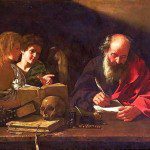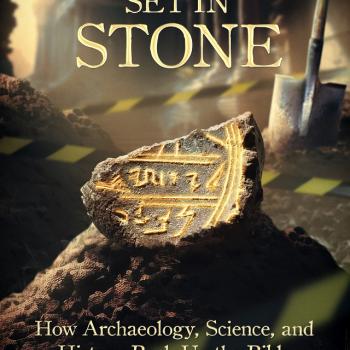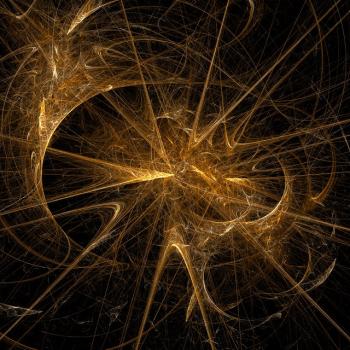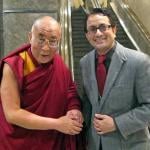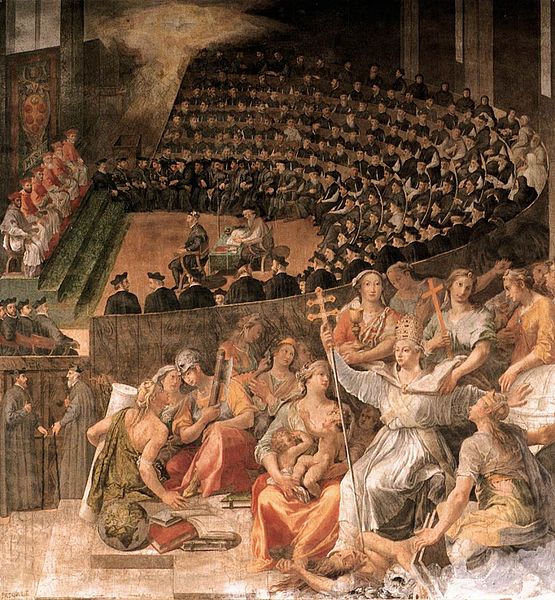
He probably wasn’t at first, as these errors tend to get progressively worse over time. Even Hans Kung was fairly orthodox in his younger years. But at least in his later period, Brown was undeniably a dissident. But because certain dense, obscurantist, sophistical, fact-twisting opponents of the Church still don’t get it, and appeal to Fr. Brown as supposedly the quintessential “Catholic scholar” over against folks like, oh, Pope John Paul II and Pope Benedict XVI (most “unscholarly types” who don’t represent mainstream Catholic theological opinion — as everyone “knows,” right?), I thought it would be good to reformulate that paper and (as an extra bonus) add a few new items, to nail the point down even more so. As it turns out, many links were no longer functioning, so this is a needed (expanded) revision of this portion of the earlier paper.
* * * * *
Sam Shamoun, a Reformed Protestant who specializes in outreach to Muslims, wrote in a letter dated 12-19-03:
By the way, do you plan on writing an expositon of Father Raymond Brown’s unorthodox, liberal views? I would love to see you tackle this from a Catholic perspective. I find myself having to expose his heretical viewpoints due to the fact that the Muslims love to appeal to his writings. It would be nice to see a Catholic write a response against him, seeing that he was a member of the Roman Catholic [Church] and was considered one of the great NT scholars.
Sam understands full well (from a Protestant perspective) that Fr. Brown was a liberal (by either Catholic or Protestant standards). The Muslim apologists with whom he deals understand it also, because they cite him, and they are notorious for citing Christian liberals in their attempt to run down the inspiration and inerrancy of Holy Scripture over against the supposedly inspired Koran. We make it easy for them: all they have to do is cite our many liberals and “higher critics” who are mocking and tearing down the Bible every day.
Would the following beliefs be considered an instance of “liberalism” by Catholic standards (and, I dare say, even by many Protestant denominational standards? Several of these beliefs certainly would have been “liberal” to me when I was a Protestant):
Fr. Brown drew sharp criticism from the late Lawrence Cardinal Shehan and others for his pioneering role “in a new Catholic theology founded on modern exegesis” that cast doubt on the historical accuracy of numerous articles of the Catholic faith.
These articles of faith, proclaimed by Popes and believed by the faithful over the centuries, include Jesus’ physical Resurrection; the Transfiguration; the fact that Jesus founded the one, true Catholic Church and instituted the priesthood and the episcopacy; the fact that 12 Apostles were missionaries and bishops; and the truth that Jesus was not “ignorant” on a number of matters.
Not least, though, was Fr. Brown’s exegesis concerning the infancy narratives of Saints Matthew and Luke that calls into question the virginal conception of Jesus and the accounts of our Lord’s birth and childhood.
In addition to Cardinal Shehan, such eminent peers of Fr. Brown as Msgr. George A. Kelly, Fr. William Most, Fr. Richard Gilsdorf, Fr. Rene Laurentin, and John J. Mulloy were highly critical of the Brown revisionism of the Catholic Church’s age-old theology of inspiration and inerrancy.
(“Traditional Catholic Scholars Long Opposed Fr. Brown’s Theories,” Henry V. King, The Wanderer, 10 September 1998; reprinted at the Catholic Culture website)
Msgr. George Kelly (raving fundamentalist and President Emeritus of the Fellowship of Catholic Scholars) has also been critical of Brown, and wrote an entire book responding to his heterodoxies, entitled, The New Biblical Theorists: Raymond E. Brown and Beyond (Servant: 1983). In an article in The Catholic Dossier, Kelly offered this delightfully satirical, half tongue-in-cheek blast at the liberal playing-with-words mentality:
During my early priestly years, I was involved in the Church’s social apostolate, with activities like the implementation of Quadregesimo Anno in the United States, and with labor unions. I learned quickly in that world how “truth”and “right”were politicized almost everywhere. We “labor priests” were not right or wrong; we were right-wing or left-wing. A priest-advocate of Pius XI’s program of reconstruction of the social order earned the label “progressive,” but should he also favor with any vigor the same pope’s reconstruction of the family in Casti Connubii, he was looked down upon as a reactionary. By 1940 some of us stood on Columbus Circle speaking on what labor unions could do for the American family, but not until 1970 did our attention turn to what the new biblical theories were doing to the family called Church and to the Church’s right to speak authoritatively on the Bible as the Word of God. So we learned all over again how to be right-wing or left-wing, never surely right or wrong.
(“A Wayward Turn in Biblical Theory,” The Catholic Dossier, Jan / Feb 2000)
Having written a book against Brown’s views, one would expect Fr. Brown to offer a respectful, scholarly retort, perhaps clarifying some things where he may have been misunderstood, etc. But instead, he engaged in name-calling: the age-old technique of last resort for the liberal when he is revealed (by rational or biblical argument) as inconsistent or heterodox:
Some of his critics, like some of his associates, were better at hurling epithets than at debating, but Fr. Brown was a match for them. He became one of the Church’s best rhetoricians for biblical criticism, fully conscious of the strengths in his positions, unwilling to admit weakness in his method or to let his critics off his rhetorical hook. He publicly questioned the competency of bishops to deal with biblical questions. His favorite terms for the critics of his theories were the following: “ultra-right,” “fundamentalist,” “ultra-conservative,” “right-wing vigilantes,” and “extremists.” Their opinions, he insisted, had “no scholarly respectability.” Labeling like this, which in our society creates impressions not necessarily true or valid, raised doubts in many Catholic quarters about traditional religious formulas.
Apologist types like myself are used to the usual liberal name-calling. One of their favorite epithets for orthodox Catholics (and those who defend same) is “fundamentalist.” So, for example, in a review of my second book, More Biblical Evidence for Catholicism, someone wrote (on amazon.com) that this was merely “Catholic fundamentalism,” and that readers ought to read some solid books of (by implication) right-down-the-center (read, “progressive”) Catholicism, by none other than Raymond Brown. So the orthodox folks become “fundamentalists” and the liberals become mainstream and “orthodox.” Very interesting. Just like opposition to homosexual behavior and “marriage” will soon, no doubt, also be considered “fundamentalist,” etc. (just as opposition to divorce, abortion, and contraception now is). Here is the entire review (for some odd reason it has been removed from the site; I certainly didn’t do it):
(1 star out of a possible 5)
More Catholic Fundamentalism, June 11, 2002
Reviewer: A reader from Trenton, NJ
Like the first book, this book suffers from the same weaknesses. Dave is to be commended for his zeal for the Catholic Church, but he needs to develop a more nuanced and sophisticated approach to Catholicism. This is more of the same – Catholic fundamentalism posing as orthodoxy. I put Dave in the same boat as James Akin, Karl Keating, Bob Sungenis, and the other fundamentalist Catholic apologists (fundapologists). Save your money and buy the Catechism of the Catholic Church is you want to learn about Catholicism. If it’s biblical exegesis that interests you, pick up anything by the best Catholic scripture scholar of all time – Raymond E. Brown.
The same guy wrote in his negative Amazon review of my first book, A Biblical Defense of Catholicism:
(1 star out of a possible 5)
Catholic Fundamentalism, June 11, 2002
Reviewer: A reader from Trenton, NJ
Dave writes well and has good intentions, but he brings to Catholicism an evangelical/fundamentalist mindset. If you want to understand Catholicism buy a copy of the Catechism. If you want to read the best in Catholic biblical scholarship, pick just about anything by Raymond E. Brown.
This review is no longer online, either. Perhaps the reviewer later figured out that he was in error and removed it himself. One can only hope.
The liberal Catholic priest and sociologist Andrew M. Greeley exhibits this same mindset, in his article, “Catholic Culture Wars: The Search for a New Archbishop”:
Those who insist on the importance of the traditional values emphasize institutional authority. For them Catholicism for all practical purposes is authority. In this paper they are called FUNDAMENTALISTS because for them church authority plays a role not unlike the bible plays for fundamentalist Protestants. Those who want a continuation of the more moderate policies of the late Cardinal would argue that Catholicism has never been a rigidly exclusionist tradition. They are therefore called PLURALISTS . . . the FUNDAMENTALISTS believe that to be true to Catholic authority a new Archbishop must “crack down” on those who advocate the ordination of women, on those who practice birth control, on priests who engage in absolution services at Christmas and Easter, and on politicians who do not fight against abortion. The PLURALISTS would rather have an archbishop who is more tolerant on these matters. It is worth nothing that this toleration might not necessarily indicate infidelity to doctrine, but a prudential judgment about what is most likely to effective in a given set of circumstances.
Note the curious shifting and re-defining of terms. Fr. Greeley refuses to use the category of “orthodox Catholics.” Instead, those who simply accept the Church’s teaching are “fundamentalists” and those who do not are the very tolerant- and open-minded-sounding “pluralists.” These folks recognize the astounding reality that Other People Believe Different Stuff Than We Do. They must never be described as “liberals” or “dissenters” or “heterodox,” for that would mean calling them what they in fact are, and conceding the terminology to the “fundamentalists.” Instead, terms such as “progressive” or “pluralist” or “moderate” or “centrist” are (and must be) used (just as in politics). I find this both silly and an insult to one’s intelligence.
Msgr. Kelly noted some of these troglodyte “fundamentalists” who disagreed with Fr. Brown:
In the world beyond journalism, Fr. Brown did acquire his own share of scholarly critics, but he paid them no mind. Msgr. Jerome Quinn, at one time (1980) the only U.S. member of the Pontifical Biblical Commission, disagreed with Browns views on the ordination of women. Paulist Neil McEleney, a 1979 President of the Catholic Biblical Association, considered Brown’s view of Mary’s role in Christ’s life as “minimalist.” John McKenzie, S.J., author of the impressive Dictionary of the Bible, thought that Brown hedged his controversial conclusions with the appearance of objectivity, while marshaling his evidence in favor of the position to which he was committed. Dennis McCarthy, S.J., a professor at the Biblicum in Rome, suggested (1979) that Brown operated out of a “squirrel cage,” i.e. he ran round and round in circles, always returning to the same place — doubt.
Here is an example of liberal tolerance for dissenting views:
What really brought me into the world of biblical controversy was meeting Fr. Manuel Miguens, O.F.M., in 1975. Fr. Miguens had studied Scripture in Rome and Jerusalem, held doctorates in both Sacred Scripture (SSD) and Sacred Theology (STD), taught for thirteen years at Jerusalem’s Studium Biblicum Francicanum and for six years at The Catholic University of America, where he was the highest degreed professor in his field, well-accepted by his students, and praised to me by the head of his department. He was the author of two books: The Virgin Birth: An Evaluation of Scriptural Evidence and Christian Ministries.
After his six successful years at Catholic University, Fr. Miguens was denied tenure because he was a critic of modern historicist exegesis as practiced, and of Fr. Brown. A Spanish-born visitor to the American Church, a private personality without powerful friends, he later came to St. John’s University in New York, but never again taught students worthy of his intellect or his learning. The very academic freedom proposed in theory to protect unpopular opinion was no help to the modest Miguens. If his likes could be driven so easily from a bishop-owned university without defense by anyone in authority, and Charles Curran given tenure in the same period, the Catholic world was itself in a “squirrel cage.”Miguens, a victim of politics, was himself uninterested in the politics of self-defense. He left CUA quietly.
Based in part on disgust at “power politics” nonsense like this, Msgr. Kelly wrote his book critiquing Fr. Brown. Here is his story about it:Fr. Brown did not ignore The New Biblical Theorists. He looked upon it as nothing more than “ultra-conservative propaganda.” Nor could he resist adding: “It was astonishing to me that Rene Laurentin had written a foreword to such a book.” Psychic transference of a kind also appeared in print, when Brown’s friend, Jerome Murphy-O’Connor, O.P., who knew nothing about my psyche or me, analyzed my state of mind as follows: “Kelly’s book generates anger; the thinly veiled animosity, the incessant slurs, the pervasive bitter righteousness.” The same Murphy-O’Connor later accosted Laurentin in Europe, to whom he vented indignation that the Frenchman could have written such a foreword which, he said, places Laurentin outside of the mainstream of American biblical scholarship. By 1983 it was clear that “the knowledge class” had acquired in their own mind “counter-magisterium” status, and its chief spokesmen had come to resent challenges to their views of early Christianity . . .
As the evidence makes clear, regnant academics in our day exercise unusual authority over Catholic opinion, and have become somewhat choosy about who is allowed to criticize their work. They also take umbrage at critics outside their mainstream, and are not happy with the likes of Cardinal Ratzinger either.
In spite of these limits placed on amateur commentators, permit this outsider to critical exegesis to single out the kind of problem historicists create for the Church, which they do, not by educing new facts, but by spinning unprovable theories. And then calling their deductions “science.”
Fr. Brown’s position on the virginal conception of Jesus is a good example. The Sulpician believed, as a matter of faith, that the Churchs teaching on this subject was true. At one point in his deliberations he also presumed that the teaching had been infallibly defined by the Church’s Magisterium. However — because some Protestants and some Catholics deny it, we must study the question again. Brown studies it and finds (at first) that “the scientifically controllable evidence” leaves Mary’s virginity an unresolved problem. Challenged by other scholars for ignoring the place of dogma in Catholic exegesis, Brown later modified his scholarly doubt by locating the problem instead in the lack of “scientifically controllable biblical evidence.” At the end of his analysis he raises one more question: Suppose, in view of the new historical insights, that the doctrine of the virginal conception is not really infallible, after all?
Fr. Brown was a good, orthodox Catholic? What does that mean, then? Msgr. Kelly summarizes Fr. Brown’s dissenting opinions:
In conclusion, permit me to capsulate the scientific conclusions of historical criticism about the origins of Catholicity, based on what Fr. Brown called “my detective work.”
* The stories of Christ’s birth are dubious history.
* Early Christians understood themselves as a renewed Israel, not immediately as a new Israel.
* We must nuance any statement which would have the historical Jesus institute the Church or the priesthood at the Last Supper.
* In the New Testament we are never told that the Eucharistic power was passed from the Twelve to missionary apostles to presbyter-bishops.
* Only in the third and fourth century can one take for granted that when “priests” are mentioned, ministers of the Eucharist are meant.
* The Twelve were neither missionaries or bishops.
* Sacramental powers were given to the Christian Community in the persons of the Twelve.
* Presbyter-bishops described in the New Testament are not traceable “in any way” to the successors of the Twelve.
* The episcopate gradually emerged, but can be defended “as divinely established by Christ” only if one says it emerged under the guidance of the Holy Spirit.
* Peter cannot be looked upon as the Bishop of the early Roman Church community. Succession to his Church fell to the Bishop of Rome, the city where Peter died. However, that concentration of authority produces, says Brown, “difficulties such as those we are now encountering within Catholicism.”
* Vatican II was “biblically naive” when it called Catholic bishops successors of the Apostles.
* It is dangerous to assume that second century structures existed in the first century.But we’re all supposed to be good little Catholics and accept Fr. Raymond Brown as a fully orthodox “one of our own” because the liberals say so and because to not do so would open us up to the horrifying, discussion-stifling charge of being “fundamentalists,” “ultraconservatives,” “reactionaries” and other “shut up”-type epithets from the liberal overlord catalogue of censorship-and-evasion of the issues by-name-calling.
Msgr. Kelly wrote in his book, Inside My Father’s House (New York: Doubleday, 1989), about the Oh-So-Tolerant-and-Smart-and-Superior liberals’ reaction to his book, The Crisis of Authority (Chicago: Regnery Gateway, 1982):. . . an interlocking directorate of Catholics and non-Catholics, of theologians and academic freedom fighters, was heaping praise on the critical exegetes and fending off complainers with charges of fundamentalism or scholarly ignorance. Father Brown and Father McCormick, each time they would suggest a change in a Catholic doctrinal position, would defend themselves by appealing to dogmatist Father Dulles, who at the time was calling his critics “right-wingers” and accusing Rome of making doctrinal statements which evaded “in a calculated way” the findings of modern scholarship.
(p. 280)Kelly offers an insightful critique of the Brown “historicist” mentality:
. . . defenders of the Faith are surely correct when they maintain that the conflicts over faith and morals following the Council, are related to the scholarly obsession with the historical method divorced from Church tradition. Historicists argue that all human propositions (in scripture, in dogmas, in morals), including those about Christ and the Church, are conditioned by the historical situation from which they derived, limiting their value or truthfulness for later centuries. When historicist exegetes so interpret scripture, independently of anything the Church has said about it, they assert for their class an authority over the final determination of what God, Moses, and Christ really said or did or they raise doubts about the truth of Church determinations which they cannot resolve by their “science.” Within this framework whatever is historically relevant to Christianity, indeed to religious life of any kind, no longer belongs to the successors of the apostles to determine.
(p. 285)Joseph Cardinal Ratzinger (now Pope Benedict XVI) made a similarly devastating critique in 1984:
The link between Bible and Church has been broken. Historico-critical interpretation of Scripture has made of it an entity independent of the Church: The Bible is read not starting from the Church and in company with the Church, but starting from the latest method claiming to be “scientific.” Only thus it is asserted, can the Bible be read correctly . . .
Thus the final word on the Word of God no longer belongs to the lawful pastors, to the magisterium, but to the expert, to the professor, to ever changeable hypotheses. We must begin to see the limits of an exegesis which really is itself a reading conditioned by philosophical prejudices, by ideological pre-understandings, and which does nothing but substitute one philosophy for another.
(in Kelly, ibid., 291)
In his book, The Crisis of Authority, Msgr. Kelly shows us what Fr. Brown believed about Scripture:
Brown may fully accept, as he says (Theological studies, March 1981, p. 4), “the Roman Catholic doctrine of the Bible as the word of God”, but it is difficult for an open-minded reader of this article to be sure after reading it just where that word would be found. Brown compiles a long list of places where the word of God may not be found — neither in the Wisdom books, nor in the Psalms, nor in the Prophets and Moses, not even in the “sayings of Jesus” which often are “Church-foundational”, not the words of Jesus at all. Says Brown: “Although theoretically these words were spoken in the early 30s, often there is little evidence that they influenced Church life in the next few decades” (ibid., p. 12). If the believer at a loss with the Bible thinks he can then turn to the Church to discover there whatever simple word of God might ever have been contained in scripture, he will learn from Brown that it is not possible to accept the stated Church view that the Bible was inspired of God and inerrant. Brown puzzles why our own “insecurity” keeps pushing us to look for “absolute answers” in our search for biblical meaning. The Brown Bible is a very different book from what “Catholics who have little knowledge of the Bible and make simple assumptions” believe. . . . At best Christians must depend on scripturists to discover what little bit of God’s word might be found there . . . Brown downgrades all the Church’s most solemn statements about scripture.
(pp. 104-105)For more about Raymond Brown’s treatment of Holy Scripture, “The Magnificat According to Raymond E. Brown,” by Thomas W. Case (try this web page for alternate URLs if the above link fails): a review of Fr. Brown’s 1977 (revised in 1993) book, The Birth of the Messiah, is quite illuminating:
Brown refuses to decide whether or not Luke (the physician friend of St. Paul) is the true author of the Gospel of that name. He will, however, use the name “Luke” for the sake of convenience. In any case, he sees this author as composing in general the infancy narrative, but not the canticles appearing in the narrative. (The canticles Brown refers to are the angelic Gloria in Excelsis, the Magnificat, the Benedictus by Zechariah, and the Nunc Dimittus by Simeon.)
He claims the Magnificat fits poorly into the scene at hand, but is rather in the likeness of a traditional Hebrew hymn in praise of God. He finds it full of “non-Lucan” Hebraic phrases. For these and other technical reasons Brown argues for Luke having discovered it in an early Jewish Christian community centered in Jerusalem, and then adapted it and placed it on the lips of Mary in the Visitation scene. . . .
Such free-wheeling artistic license, Brown says (pg. 347), “is not a question of a purely fictional creation, for the dramatis personae are remembered or conceived of as representative of a certain type of piety which the canticles vocalize.” But I would say an author’s pulling together various quotations from various sources and putting them in the mouths of various speakers — “remembered or conceived” — is fiction pure and simple, if not purely creative fiction. . . .
But, says Brown (pg. 341), “Virtually no serious scholar would argue today that the Magnificat was composed by Mary.” Whenever I hear a pundit engaging in such ad hominem statements, I smell a rat. I immediately suspect there are indeed serious scholars who argue that the Magnificat was composed by Mary (or rather, inspired by God and uttered by Mary). These scholars are just not in Brown’s camp. There is and has been, for two centuries, a methodology in biblical criticism carrying with it an agenda. . . .
But taking an utterly rational, “critical” approach to Scripture is part of the problem. To deal with the Christmas stories in Luke and Matthew purely as if they were ancient pieces of literature, while setting aside (for the purposes of the analysis) God and the Christian Faith, is itself an irrational pose. It is a mistake to treat Scripture as if were a secular book, to be torn apart, manipulated, and stripped of whatever events seem incredible to the analyst. The Faith gave us Scripture, and God gave us the Faith. Forgetting any part of that equation is to describe a wagon without wheels and without the horse that draws the wagon. How can you get rid of scriptural stories talking of events leading up to Christmas without eventually getting rid of those events, and eventually getting rid of Christmas?
In a letter to the Homiletic and Pastoral Review, March 2000, Fr. Brian W. Harrison, O.S., wrote:
Editor: Rev. Philip M. Stark’s defense of Fr. Raymond E. Brown’s orthodoxy (HPR, Aug.-Sept. 1999) is based principally on the consistent approval given to the late biblical scholar by Vatican authorities, who secured his appointment for two terms as a member of the Pontifical Biblical Commission.
While such approval would seem to create a strong presumption in favor of Brown’s orthodoxy, I believe that such a presumption is overturned by the hard evidence of Brown’s clearly and constantly expressed positions and their equally clear contrast with two doctrines infallibly proposed by the Catholic Church’s universal and ordinary magisterium: (a) that the Holy Spirit—who cannot err—is the simultaneous author of everything affirmed by the Biblical writers; and (b) that the canonical Gospels “always” (not just “usually” or “sometimes”) tell us what is historically true about Jesus (cf. Dei Verbum 11 and 19, with their accompanying official footnote references).
. . . Fr. Brown was an exegete, not a dogmatic theologian. My own recently awarded doctorate in Theology (summa cum laude, from a Pontifical Roman university) is precisely on the dogmatic teaching of the Catholic Church in regard to Sacred Scripture, as expressed and confirmed in the conciliar and post-conciliar documents of Vatican II and their chief signatory, Pope Paul VI. My research has persuaded me that Fr. Brown’s undoubted erudition in Scriptural matters, far from guaranteeing him any special competence to interpret the relevant Roman documents, as Fr. Stark supposes, made him a far from impartial judge of what those documents really mean and teach.
Like countless other post-Enlightenment exegetes of all denominations, Brown had become convinced by his own brand of historical-critical “science” that the Biblical writers sometimes make mistaken affirmations, and that parts of the Gospels very probably belong to certain less-than-historical literary genres. But since, by all accounts, he was also strongly motivated to remain a loyal Catholic as well as a “critical” exegete, Brown seems to have been unable to resist the temptation to indulge in “concordism,” i.e., to translate and read the pertinent magisterial documents with a strong liberal bias, so as to harmonize them at all costs with his own “scientific findings.” Unfortunately, the Catholic Biblical “establishment” since Vatican II has generally followed him in this.
I suspect that the harm which Raymond Brown has unwittingly done to the Church and to souls has been more grievous than that done by theologians more outspokenly liberal than Brown himself, precisely because the “moderation” and “nuances” with which he sugar-coated his pernicious doctrinal principles made his work seem responsible and orthodox to many high-ranking bishops and cardinals who would never have been swayed by the more blatant (although perhaps more logically consistent) biblical skepticism of those such as Küng, Boff, Schillebeeckx, Knitter, or Drewermann.
Joseph Cardinal Ratzinger offered an insightful analysis of the mindset and mentality and false presuppositions of this sort of “post-Enlightenment” historicism (which is, sadly, very common today):
Broad circles in theology seem to have forgotten that the subject who pursues theology is not the individual scholar but the Catholic community as a whole, the entire Church. From this forgetfulness of theological work as ecclesial service derives a theological pluralism that in reality is often a subjectivism and individualism that has little to do with the bases of the common tradition . . .
In this subjective view of theology, dogma is often viewed as an intolerable straitjacket, an assault on the freedom of the individual scholar. But this loses sight of the fact that the dogmatic definition is rather a service to the truth, a gift offered to believers by the authority willed by God . . .
Some catechisms and many catechists no longer teach the Catholic faith in its harmonic wholeness — where each truth presupposes and explains the other — rather they try to make some elements of the Christian patrimony humanly ‘interesting’ (according to the cultural orientations of the moment). A few biblical passages are set in bold relief because they are viewed as being ‘closer to contemporary sensibility’. Others, for the opposite reason, are set aside . . .
The bond between Bible and Church has been broken. In the Protestant sphere this separation began at the time of the Enlightenment in the eighteenth century and of late has also found entry into some Catholic scholarly circles. The historico-critical interpretation has certainly opened many and momentous possibilities for a better understanding of the biblical text. But by its very nature, it can illumine it only in its historical dimension and not explain it in its present-day claim on us. Where it forgets this limit it becomes illogical and therefore also unscientific . . . for many the traditional faith of the Church no longer seems justified by critical exegesis but appears only as an obstacle to the authentic ‘modern’ understanding of Christianity . . .
. . . a church without a credible biblical foundation is only a chance historical product, one organization among others, and the humanly constructed framework of which we spoke. But the Bible without the Church is also no longer the powerfully effective Word of God, but an assemblage of various historical sources, a collection of heterogeneous books from which one tries to draw, from the perspective of the present moment, whatever one considers useful. An exegesis in which the Bible no longer lives and is understood within the living organism of the Church becomes archaeology: the dead bury their dead. In any case, the last word about the Word of God as Word of God does not in this conception belong to the legitimate pastors, the Magisterium, but to the expert, the professor with his ever-provisional results always subject to revisions . . .
. . . Scripture has again become a closed book. It has become the object of experts. The layman, but also the specialist in theology who is not an exegete, can no longer hazard to talk about it. It seems to have almost been withdrawn from the reading and the reflection of the believer, for what would result from this would be dismissed as “dilettantish’. The science of the specialists has erected a fence around the garden of Scripture to which the nonexpert now no longer has entry . . . . .
Every Catholic must have the courage to believe that his faith (in communion with that of the Church) surpasses every ‘new magisterium’ of the experts, of the intellectuals . . . The rule of faith, yesterday as today, is not based on the discoveries (be they true or hypothetical) of biblical sources and layers but on the Bible just as it is, as it has been read in the Church since the time of the Fathers until now. It is precisely the fidelity to this reading of the Bible that has given us the saints, who were often uneducated and, at any rate, frequently knew nothing about exegetical contexts. Yet they were the ones who understood it best.
(The Ratzinger Report, Joseph Cardinal Ratzinger with Vittorio Messori, translated by Salvator Attanasio and Graham Harrison, San Francisco: Ignatius Press, 1985, 71-72, 73-76)
Michael E. Giesler provides further analysis of Fr. Brown’s errors, in his article “Brown’s Birth of the Messiah . . . Revisited” (Homiletic and Pastoral Review, February 2001, 16-24; reprinted at Catholic Culture site):
His methodology is the strict application of the historical-critical method, as he states in footnote 2 of the Introduction. In his presentations, at least initially, he does not take into account later statements of the Magisterium or the Fathers of the Church, but restricts himself to the texts at hand, or ancient documents from secular or Jewish sources such as the dead sea scrolls. He obviously thinks that this is the scientific and empirical way to do Scripture studies, and that it is truly ecumenical as well. Only later in his analysis does he consider Magisterial statements, in a somewhat secondary way. For this reason he frankly admits that he sees “no reason why a Catholic’s understanding of what Matthew and Luke meant in their infancy narratives should be different from a Protestant’s” (p. 9). . . . he questions the historicity of the infancy narratives — thereby reinforcing his central vision of their theological message and design. . . .
I believe that his questioning of the historicity of many passages is itself problematic. For instance, he questions the historicity of the Annunciation to Mary because of the stereo-typical literary form used (p. 296). . . .
The author is continually looking for sources or traditions (whether pre-Mathaean or pre-Lucan), to the point that the reader gets the impression that the infancy narratives are a mere literary artifice. At some points the desire to find a previous source goes beyond common sense. On page 106 for instance he interprets that the two dreams that Joseph had are indications of two “pre-Mathaean sources” — one for each dream, as well as one for each geographical destination to which Joseph is directed. But the evident and most straight-forward approach is that Matthew recorded two dreams because his source (written or verbal) described two dreams in the first place. There is no need to hypothesize about the existence of more sources, though it may appear more scholarly and sophisticated to do so. He does make a valid point, I think, in showing that the Scriptural formula citations have a certain literary form that could be more Mathaean, and therefore could have been added to a pre-existing narrative.
On page 346 he states that it is “pre-critical and naive” to say that Mary actually spoke the words of the Magnificat. Apart from the fact that this would mean that the Church’s preaching tradition has been “naive” for the past 1950 years, there is no reason to suspect that a holy woman, who must have reflected on Scripture before and was moved by the Holy Spirit, could not have uttered the words of the Magnificat (or at least their substantial content) particularly in the grace-filled context of a visit to her cousin Elizabeth. . . .
The author’s rather stringent view of biblical history can also be seen on page 513 when he states that “only the second chapters of the infancy narratives of Matthew and Luke support Bethlehem as the birthplace of Jesus.” The logical question arises: isn’t that enough? . . .
In speaking of the evangelists’ sources he immediately discounts that the Matthaen infancy narrative could have come from Joseph and that the Lucan infancy narrative came from Mary (p. 525). He argues that the “Matthaean and Lucan annunciation accounts are developed variants of a pre-Gospel annunciation tradition”(p. 525). But if this were so, what could impede that this pre-Gospel annunciation tradition was itself based on real historical events, and that Mary and the friends and relatives of Joseph — if he was deceased at the time of Matthew’s original Aramaic account — could have been the sources for the Gospel? . . .
In general his arguments are not convincing. He works always within the realm of speculation — a necessary condition for him since he questions that the infancy narratives were founded on eye-witness reports; therefore his major activity is one of nuance and distinction. It is neither a positive affirmation, nor a well-proven denial. The reader is continually left in a kind of exegetical limbo about the real meaning of the events of Christ’s infancy; the one sure thing, according to the author, is the theology woven into it by Matthew and Luke.
As it stands Brown’s book has underlying assumptions that make it hard to be used by a Roman Catholic who wants to see the infancy narratives in an integral way, connected with the traditions and practices of the Church. In great part this difficulty comes from Brown’s initial premise: that the Bible itself can be studied as an end in itself, in only a historical-critical way, without reference to a greater context or truth. This is an unreal starting point, almost like isolating a cell of the body without its reference to the body in general. The books of the Bible were obviously written within a tradition, and for a tradition — and this must always be kept in mind. . . .
It seems very far-fetched to say that the Holy Spirit could have allowed the Church to be in the dark about the infancy narratives for so many centuries, or have allowed the piety of the people to be nourished on a mere theological-literary artifice but that now with the advent of historical-literary criticism “the real truth” about the infancy narratives has been discovered. . . .
It is true that in 1971, when he wrote the book, he was using the method which the Pontifical Biblical Commission, though no longer an organ of the Magisterium, would later recommend to all Catholic exegetes as a necessary step towards discovering the meaning of the text: the historical critical method (cf. Pontifical Biblical Commission, The Interpretation of the Bible in the Church, St.Paul Books and Media, Boston, 1993, p. 35). That is, a careful analysis of historical and literary sources is important for determining the human mind of the author — his intention, theological purpose, and audience. The historical critical method has value because of the incarnational nature of revelation, since God chose to reveal his eternal word within the limitations of the human author. But Pope John Paul II in his introduction to the document, and later the PBC itself in various passages, are careful to note that this method needs to be freed from “its philosophical suppositions or those contrary to the truth of our faith” (see p. 20) . These presuppositions, among other things, carry with them the denial of the supernatural in history, and the excessive attention to the human or time-limited element in Scripture. In addition, one must also realize that this method like all human sciences does not determine the literal meaning of a text, but is simply a tool for understanding it (cf. St.Thomas Aquinas, In Boeth. de Trinit., q.2, a.3, ad 1). . . .
Over the years I think that Fr. Brown modified some of his views. One of his final works, Introduction to the New Testament (Doubleday, New York, 1997), is meant to be more centrist and does show a greater awareness of essential Catholic teachings. In some texts he even tries to integrate some theories of higher criticism and Catholic teachings — no easy task for a modern Scripture scholar who wants to be accepted by the biblical establishment. For this he is to be commended. He even has a forceful criticism of the excesses of the “Jesus Seminar,” with its blatant denial of the historicity of many gospel passages. Yet the content and tone of the book remains strongly historical-critical, and it fails to present a truly unified view of the relationship between higher criticism and the living tradition of the Church.Likewise, Kenneth D. Whitehead makes similar observations:
America’s Foremost Catholic Biblical Scholar?Msgr. George A. Kelly in his book. The New Biblical Theorists (1983), looks carefully at the work of the late Sulpician priest Fr. Raymond Brown as the most prominent member of a whole school of post-Vatican-II Catholic exegetes committed to critical methods. He shows Fr. Brown and his “school” to be rather far from being in compliance with the requirements for sound Catholic exegesis laid down by Vatican II.
Although Fr. Brown and his typical colleagues have customarily claimed to be interpreting Scripture in accordance with Providentissimus Deus and Divino Afflante Spiritu, Msgr. Kelly shows the reality to be rather different. Little attention is generally paid by most of these new Catholic exegetes to the Tradition of the Church or to the analogy of faith; they regularly approach Scripture piecemeal, in isolation, and from an almost wholly naturalistic perspective. Msgr. Kelly identifies numerous opinions of Fr. Brown that appear to be in conflict with the established faith of the Church, such as:
- The stories of Christ’s birth represent dubious history.
- The virginal conception of Jesus is an unresolved historical problem.
- Any idea that Christ instituted the Eucharist at the Last Supper must be “nuanced.”
- The Twelve were neither missionaries nor bishops.
- Sacramental powers were given to the whole Christian community (not just to the “ordained” clergy).
- Vatican II was “biblically naive” when it called the Catholic bishops successors to the apostles, and so on.
When such opinions as these—and we have cited only a few identified by Msgr. Kelly—are tranquilly espoused by the man considered to be America’s foremost Catholic biblical scholar, then it would seem that there is a very real problem with some Catholic biblical scholarship today as it relates to the faith of the Church. The Tradition of the Church, particularly the Church’s living magisterium, is, in fact, rarely even mentioned by most of America’s contemporary Scripture scholars. It is not so much that they adopt a position of open dissent from the teachings of the magisterium, as so many moral theologians do today: On the contrary, they customarily claim to be wholly loyal to the Church and her teachings. In practice, though, they lecture, write, and publish as if the magisterium did not exist.
(“Biblical Scholarship and the Faith of the Church,” Crisis Magazine, April 2000; reprinted at Catholic Culture website)
The following observation from Fr. Brown (from the Wikipedia entry) illustrates the cavalier, condescending way in which he approached Church documents having to do with Holy Scripture:
Dei Verbum cited two earlier papal promulgations (in addition to certain Patristic texts) Providentissimus Deus (1893) and Divino Afflante Spiritu (1943). Providentissimus Deus stated, “it is absolutely wrong and forbidden, either to narrow inspiration to certain parts only of Holy Scripture, or to admit that the sacred writer has erred”.[11] Divino Afflante Spiritu, the document which established the parameters in which Catholic Biblical exegetes could legitimately apply the use of biblical criticism,[12] quoted and reaffirmed the citation from Providentissimus Deus, adding that divine inspiration “not only is essentially incompatible with error but excludes and rejects it as absolutely and necessarily as it is impossible that God Himself, the supreme Truth, can utter that which is not true. This is the ancient and constant faith of the Church.”[13]
Brown rejected the view that this implied the position had not changed: “Essential to a critical interpretation of church documents is the realization that the Roman Catholic Church does not change her official stance in a blunt way. Past statements are not rejected but are requoted with praise and then reinterpreted at the same time. … What was really going on was an attempt gracefully to retain what was salvageable from the past and to move in a new direction at the same time”.[14]
Even a Protestant anti-Catholic lay apologist like Jason Engwer understands that Fr. Brown is heterodox, not only by Catholic standards, but evangelical Protestant criteria as well:Brown, who died in 1998, was somewhat liberal, but he wasn’t an anti-supernaturalist, and he agreed with conservatives on some significant issues. . . . If the narratives were as unhistorical as Brown and other modern scholars claim, then the early enemies of Christianity would have been in a position to know it, often to easily know it. . . . Brown’s dismissals of eyewitness testimony, for example (p. 27, etc.), are far outweighed by the contrary arguments cited by Richard Bauckham and other scholars. . . . Over the next couple of days, I want to quote some examples of Brown’s more conservative conclusions about the infancy narratives. We seem to hear much more about his more liberal conclusions, but he also agreed with conservative scholarship on some points.
(11-6-07)
If Raymond Brown had more consistently given such factors the weight they deserve, he would have reached far more conservative conclusions. The same can be said of modern Biblical scholarship in general, and not just with regard to the infancy narratives.
(11-8-07)
. . . liberals like Brown and Carrier . . .
(12-10-07)
. . . Raymond Brown and other modern critics . . .
(12-15-07)
. . . Raymond Brown and other liberal critics of the infancy narratives . . .
(1-2-08)
. . . John Meier and Raymond Brown, neither one a conservative. . . . Brown was a liberal who was wrong on many points, . . .
(1-14-08)
A few decades later, other scholars (recently Joseph Kelly, Geza Vermes, Marcus Borg, and John Crossan, for example) have joined Brown in advancing a liberal view of the infancy narratives, with much influence in academia and the media.
(12-22-08)
Even a scholar as generally skeptical of the infancy narratives as Raymond Brown wrote . . .
(1-16-09)Fellow anti-Catholic blogmaster Steve Hays agrees:
And what does Brown say? “In principle there can be no objection to designating as pseudonymous 2 Peter, Jas, Jude, and the Pastorals, Col, Eph, and 2 Thes” (1051).
(8-11-08)
. . . heretical priests like Ray Brown who lead the faithful away from Christ.
(10-4-08)Curiously, however, fellow anti-Catholic luminary Bishop James White seems to have a far higher notion of Fr. Brown’s orthodoxy:
For those not familiar with Roman Catholic scholarship, Brown and Fitzmyer are names at the very top of Rome’s NT scholarship list over the past thirty years, both having worked and published at the direction of high level Papal commissions, etc. The Jerome Biblical Commentary is likewise Roman Catholic, . . .
(12-22-07)As we have seen, Fr. Brown was not an orthodox Catholic. So why do severe critics of the Church keep citing him as if he were the very epitome of “the Catholic scholar”? I think it is an instance of “using whatever club you can against an enemy, no matter how inapplicable or unfair or irrational.” The Muslims and the atheists and the Jehovah’s Witnesses have used this cynical technique for years (as evidenced by the question from Reformed Protestant critic of Islam Sam Shamoun at the top of this paper), in arguing against orthodox historic, trinitarian Christianity in general: utilize liberal scholars who don’t agree with their own ostensible faith traditions, and pretend that these represent the cutting-edge scholarship of the faith tradition being critiqued. In other words, it is the classic straw-man technique. But it won’t fly, as long as I am around to expose the ludicrosity of the method.
* * * * *


